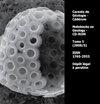Pliocene bivalves (Pteriomorphia) of Algiers Sahel (Algeria): Systematics and palaeoecology.
IF 1.5
4区 地球科学
Q2 GEOLOGY
引用次数: 0
Abstract
A hundred specimens of pteriomorph bivalves were collected from the marine deposits of the marly-sandy formations of Algiers Sahel, which correspond to transitional facies between the Piacenzian deep marly deposits and the Astian molassic deposits. They are herein analysed from a systematic, taphonomic, palaeoecological and paleoenvironmental point of view. The preliminary inventory list consists of 27 species belonging to eight families: Arcidae, Nuculidae, Glycymeridae, Spondylidae, Pectinidae, Plicatulidae, Gryphaeidae, and Ostreidae. Two sedimentary units with different bivalve biodiversity are recognized: the first: a shallow infralittoral unit characterised by large Flabellipecten alessii, Aequipecten angelonii, Ostrea lamellosa and O. edulis; the second: A deeper unit of circalittoral environment mainly includes Amusium cristatum. These bivalve shells display sclerobiont traces. Bioerosion traces are mostly assignable to clionid sponges (Entobia isp.), polychaete worms (Maeandropolydora isp. and Caulostrepsis isp.), bivalves (Gastrochaenolites isp.) and predatory gastropods (Oichnus isp.). Identified encrusting organisms are juvenile oyster shells, cirripedes, polychaete worms (serpulids), and indeterminate bryozoans. Analysis of boring and encrusting traces indicate a progressive environmental change from a relative high energy setting to a lower energy and deeper water setting, and correspond to a shallow sea with well-oxygenated waters.阿尔及利亚阿尔及尔萨赫勒地区上新世双壳类(翼形目):系统学和古生态学。
从阿尔及利亚萨赫勒地区的海相泥砂地层中采集了100个拟形双壳类标本,这些标本对应于皮亚森阶深泥砂沉积与亚洲摩尔系沉积之间的过渡相。本文从系统、地层学、古生态和古环境的角度对它们进行了分析。初步清查名单共有27种,隶属于8科:姬蝇科、核蝇科、姬蝇科、棘蝇科、果胶蝇科、纹蝇科、纹蝇科。鉴定出两个具有不同双壳类生物多样性的沉积单元:第一个是以大型Flabellipecten alessii、Aequipecten angelonii、Ostrea lamellosa和O. edulis为特征的浅海下单元;第二种:圆形环境的深层单元,主要包括云母。这些双壳类动物的壳显示出坚硬的痕迹。生物侵蚀痕迹主要归属于蛭形海绵(Entobia isp.)、多毛纲蠕虫(Maeandropolydora isp.)。(Caulostrepsis isp.),双壳类(Gastrochaenolites isp.)和掠食性腹足类(Oichnus isp.)。已确定的外壳生物有幼牡蛎壳、卷足动物、多毛类蠕虫(蛇形虫)和不确定的苔藓虫。钻孔和结壳痕迹的分析表明,从相对高能环境到较低能量和较深水环境的环境变化是渐进的,对应于一个含氧良好的浅海。
本文章由计算机程序翻译,如有差异,请以英文原文为准。
求助全文
约1分钟内获得全文
求助全文
来源期刊

Carnets De Geologie
Earth and Planetary Sciences-Geology
CiteScore
2.90
自引率
14.30%
发文量
21
审稿时长
>12 weeks
期刊介绍:
Information not localized
 求助内容:
求助内容: 应助结果提醒方式:
应助结果提醒方式:


